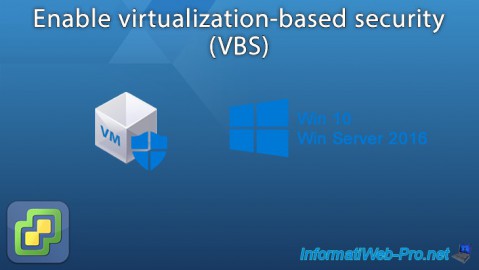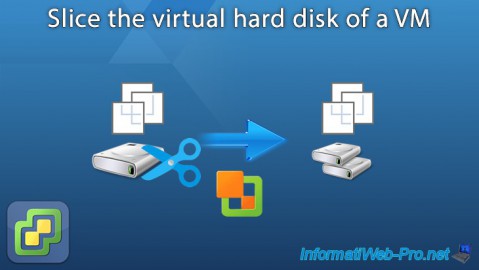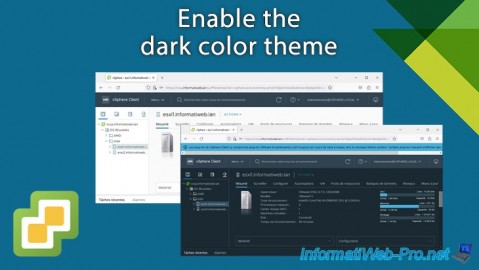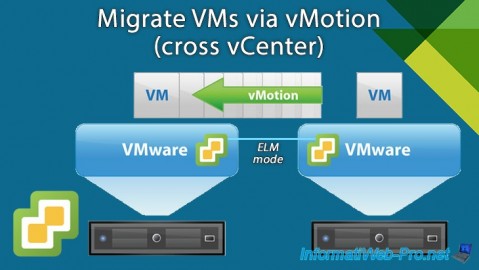Enable vSphere HA on a cluster to ensure high availability of a VMware vSphere 6.7 infrastructure
- VMware
- VMware vCenter Server (VCSA), VMware vSphere
- 28 February 2025 at 12:26 UTC
-

- 4/8
Once vSphere HA is enabled, you will see that "Configuring vSphere HA" tasks will appear for each host with the details "Downloading the vSphere HA agent installer to...".
In other words, vSphere HA takes care of automatically installing the FDM (Fault Domain Manager) agent on each host in the cluster so that vSphere HA can function correctly.


Once the FDM agent is installed on the hosts in your cluster and the vSphere HA configuration is copied to each host, the status of these tasks will be "Completed".

As you can see, vSphere HA is enabled.

If you go to "Monitor -> vSphere HA -> Summary", you will see that a host has been designated as master by vSphere HA.
The other hosts are connected to the master.

On your cluster page, you will see that a "vSphere HA" section has appeared.

As explained previously, vSphere has designated a host as master.
In our case, this is our host "esxi2".
Its vSphere HA state is therefore: Running (Master).

The other hosts in the cluster are designated as slaves. In our case, our host "esxi1" is a slave.
Their vSphere HA state is therefore: Connected (Slave).

Note that if you have not respected the prerequisites mentioned above, it is possible that one or other of these warnings appear:
- This host currently has no management network redundancy: means there is only one physical network adapter assigned for your host's management network.
To fix the issue, add at least a 2nd physical network adapter (as an "active" or "standby" adapter) to the virtual switch where the "management" service is enabled on a virtual network of that virtual switch.
Also ensure that the added physical network adapter is also marked as "active" or "standby" on the virtual network used for the "management" service.
Next, you will need to disable and then re-enable vSphere HA so that the network configuration is re-analyzed by vSphere HA. - The number of vSphere HA heartbeat datastores for this host is 1, which is less than the required number "2": as explained previously, you must use at least 2 datastores accessible by the cluster for the heartbeat signal from your VMware cluster.
To do this, select your cluster, go to "Configure -> Services -> vSphere Availability", click on "Edit" and select at least 2 datastores (accessible by all hosts in the cluster) in the "Heartebeat Datastores" tab.

If you deploy the "vSphere HA Status" section of the host designated as master, you will see that the FDM agent of this host will control the VMs protected by vSphere HA on this host, as well as on the other hosts in the cluster.
In the event of failure of another host in the cluster, it is this host designated as master which will attempt to restart the impacted virtual machines.

If you deploy the "vSphere HA Status" section of a host designated as slave, you will see that the VMs protected by vSphere HA on this host will be controlled by the FDM agent of the host designated as master (vSphere HA Master) in your cluster.
It is the master host's agent that will attempt to restart the virtual machines of this slave host on other functional hosts in the cluster if this slave host fails.

When vSphere HA is enabled on a VMware cluster, you will notice that additional data will be created on the cluster's datastores.
In this case, those selected for the heartbeat signal via shared storage.
To see it, select your cluster, then go to the "Datastores" tab.
In the list, click a previously selected datastore (in vSphere HA settings) for heartbeat via shared storage.
In our case, we click on our "iSCSI DS 1" datastore.

On the datastore page that appears, go to the "Files" tab.
As you can see, a ".vSphere-HA" folder has been created at the root of it.

If you go into this ".vSphere-HA" folder, you will see that a "FDM-[unique identifier]" folder is there and refers to the FDM agent that was installed on each host in the cluster during enabling vSphere HA.

9. VM overrides
When you enable vSphere HA on a VMware cluster, the cluster settings are applied to all virtual machines in it.
However, it is possible to change some vSphere HA settings for specific virtual machines by selecting the relevant cluster, then going to: Configure -> Configuration -> VM Overrides.
Then click: Add.

In the "Add VM Override [cluster name]" window that appears, select the virtual machine for which you want to change a vSphere HA setting and click Next.

As you can see, you can override many default legacy settings from the vSphere HA settings defined on your cluster.
- vSphere HA: allows you to redefine the value of the "VM Restart Priority", "Start next priority VMs when" settings, ...
- vSphere HA - PDL Protection Settings: allows you to redefine the value of the "Failure Response" setting upon permanent loss (PDL) of storage on a host.
- vSphere HA - APD protection Settings: allows you to redefine the value of the "Failure Response", "VM failover delay", ... settings during the temporary loss (APD) of storage on a host .
- vSphere HA - VM Monitoring: allows you to disable monitoring of a specific VM when VM monitoring is enabled on your VMware cluster.
For detailed information regarding these settings, refer to the previous step (8. Enable VMware vSphere HA on your cluster) of this tutorial.
In fact, these are the same settings as those available in the "Failures and Responses" tab of your VMware cluster settings.
Note: for the setting concerning vSphere DRS, refer to the "VM overrides" step of our "VMware vSphere 6.7 - Enable vSphere DRS on a cluster" tutorial.

Share this tutorial
To see also
-

VMware 1/27/2023
VMware ESXi 6.7 - Enable virtualization-based security (VBS)
-

VMware 12/16/2022
VMware ESXi 6.7 - Slice the virtual hard disk of a VM
-

VMware 4/11/2024
VMware vSphere 6.7 - Enable the dark color theme
-

VMware 11/29/2024
VMware vSphere 6.7 - Migrate VMs via vMotion (cross vCenter)

No comment